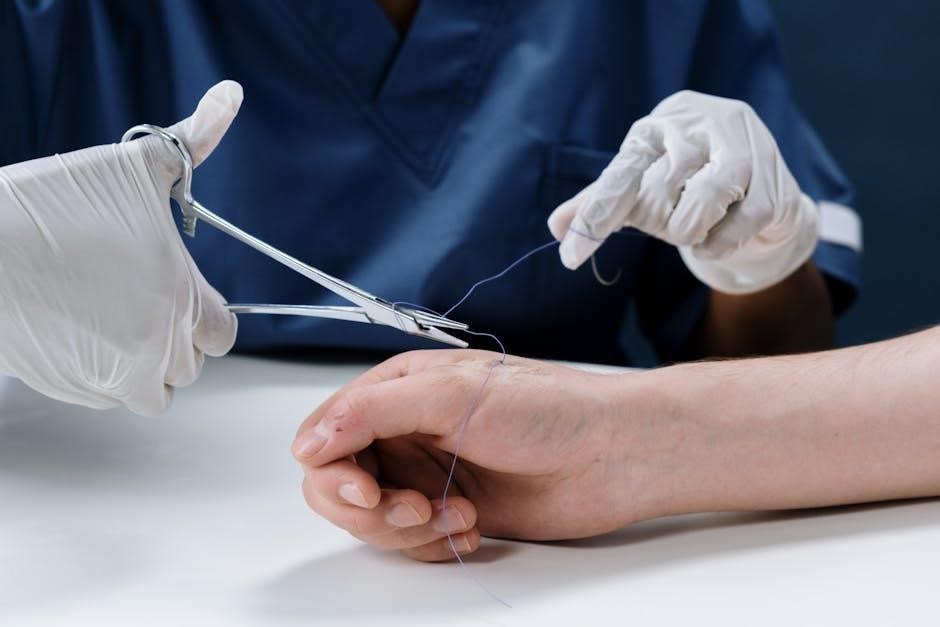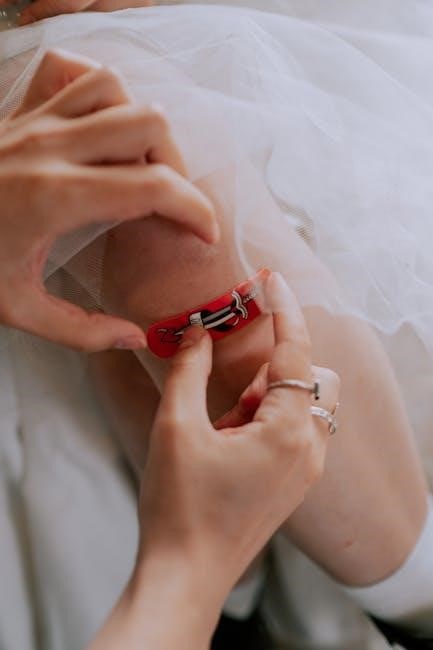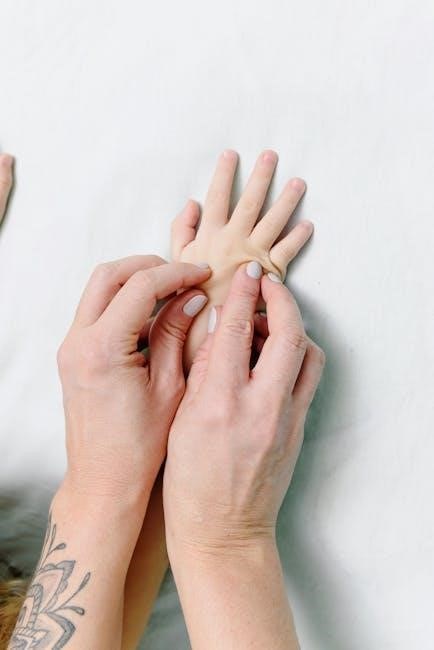The Mother Wound refers to unresolved emotional pain stemming from the relationship with one’s mother, often rooted in generational trauma. It manifests as feelings of emotional starvation, low self-esteem, or unhealthy relationship patterns. Healing this wound involves acknowledging its impact, fostering self-compassion, and breaking cycles of dysfunction passed through generations.
1.1 What is the Mother Wound?
The Mother Wound is a term describing unresolved emotional pain stemming from the mother-child relationship, often rooted in generational trauma. It involves unmet emotional needs, societal pressures on motherhood, and patterns passed through generations. This wound can manifest as feelings of abandonment, low self-esteem, or unhealthy relationship dynamics. It’s not solely about neglect but also about inherited family patterns and societal expectations that shape maternal roles and child experiences.
1.2 The Significance of Healing the Mother Wound
Healing the Mother Wound is essential for breaking cycles of generational trauma and fostering emotional freedom. By addressing unresolved pain, individuals can cultivate self-awareness, improve relationships, and reclaim personal power. This process not only enhances mental health but also empowers future generations, creating a legacy of healing and wholeness. It’s a vital step toward personal growth and emotional well-being.
Understanding the Causes and Origins
The Mother Wound stems from generational trauma and societal pressures, often resulting in emotional unavailability or over-nurturing. These patterns disrupt a mother’s ability to provide balanced support, perpetuating cycles of pain.
2.1 Generational Trauma and Its Role
Generational trauma plays a significant role in the Mother Wound, as unresolved pain and dysfunctional patterns are passed down through family lines. This inherited suffering often manifests in emotional distance or over-nurturing, perpetuating cycles of hurt. By understanding this interconnectedness, individuals can address deep-rooted issues and begin the healing process, breaking free from the past.
2.2 Societal Expectations and Their Impact on Mothering
Societal expectations place immense pressure on mothers to be perfect caregivers, often leading to emotional unavailability or over-nurturing. These unrealistic standards can prevent mothers from expressing their own vulnerabilities, causing their children to feel emotionally starved. This dynamic perpetuates the Mother Wound, as women struggle to balance societal demands with their roles as nurturing figures.

The Process of Healing
The journey to healing the Mother Wound begins with acknowledging the emotional pain and embracing self-compassion. It involves inner reflection, understanding generational patterns, and fostering a nurturing relationship with oneself, ultimately leading to personal growth and liberation from inherited trauma.
3.1 Acknowledging the Wound: The First Step to Healing
Acknowledging the Mother Wound is the cornerstone of healing. It involves recognizing the emotional pain, patterns, and generational trauma without judgment. This step requires courage to confront feelings of abandonment, neglect, or emotional unavailability. By validating these experiences, individuals can begin to release shame, anger, and resentment, creating a foundation for self-compassion and growth. This acceptance paves the way for deeper healing and transformation.
3.2 The Importance of Self-Compassion in the Healing Journey
Self-compassion is vital in healing the Mother Wound. It involves treating oneself with kindness, understanding, and patience, especially when confronting painful memories. By embracing vulnerability, individuals can transform self-criticism into empathy, fostering emotional resilience. Self-compassion creates a safe space for inner healing, allowing individuals to reconnect with their true selves and break free from generational patterns of self-doubt and unworthiness, promoting lasting emotional well-being.

Practical Strategies for Healing
Effective strategies include journaling, therapy, and support groups to process emotions. Shamanic meditation and boundary-setting also aid in releasing trauma, fostering personal growth and emotional freedom.
4.1 Journaling and Inner Reflection
Journaling is a powerful tool for healing the Mother Wound, allowing you to process emotions and uncover patterns. By writing about childhood experiences and feelings toward your mother, you can release emotional weight and gain clarity. Reflective exercises, such as prompts or free-writing, help explore unresolved wounds, fostering self-awareness and personal growth. This practice aids in understanding your mother’s limitations while cultivating compassion for yourself and her, paving the way for healing and redefining relationships.
4.2 The Role of Therapy and Support Groups
Therapy and support groups provide safe spaces to explore the Mother Wound, offering professional guidance and communal understanding. Trained therapists help identify patterns and triggers, while support groups connect individuals sharing similar experiences. These environments foster accountability, empathy, and validation, empowering individuals to confront unresolved emotions and develop healthier relationship dynamics. Engaging in these resources accelerates the healing process and builds a network of encouragement and shared growth.

Redefining Relationships
Redefining relationships involves rebuilding trust and communication, fostering healthy boundaries, and releasing toxic patterns. This process promotes emotional healing and empowers individuals to form authentic connections.
5.1 Rebuilding the Mother-Daughter Relationship
R
5.2 Setting Healthy Boundaries
Setting healthy boundaries is crucial in healing the mother wound, as it allows individuals to protect their emotional well-being and prevent the continuation of harmful patterns. By establishing clear limits, one can foster mutual respect and understanding in relationships. This process involves communicating needs clearly, prioritizing self-care, and learning to say “no” without guilt. Healthy boundaries empower personal growth and promote emotional resilience, aiding in the healing journey.

The Role of Spirituality and Science
Spirituality and science offer complementary paths to healing the mother wound. Shamanic meditation and quantum physics reveal how ancestral trauma can be resolved, fostering emotional and spiritual renewal.
6.1 Shamanic Meditation and Ancestral Healing
Shamanic meditation offers a profound pathway to healing the mother wound by connecting with ancestral wisdom. Through guided journeys, individuals access generational trauma stored in their lineage, releasing emotional and spiritual wounds. This practice fosters reconciliation with ancestral patterns, promoting deep healing and renewal; Quantum entanglement further supports this process, illustrating how interconnectedness transcends time and space, allowing for transformative breakthroughs in personal and collective healing.
6.2 The Interconnectedness of Science and Spirituality
The interconnectedness of science and spirituality reveals how quantum entanglement and ancestral healing bridge the gap between physical and metaphysical realms. Science supports the idea that emotional wounds can transcend generations, while spirituality offers tools like meditation to heal these wounds. This fusion provides a holistic approach to understanding and addressing the mother wound, emphasizing the unity of mind, body, and soul in the healing journey.

Case Studies and Testimonials
Real-life stories highlight the transformative power of healing the mother wound. Women share their journeys of overcoming emotional scars, rebuilding relationships, and finding personal empowerment. Expert endorsements and success stories illustrate the profound impact of addressing generational trauma, offering hope and inspiration for those beginning their own healing paths.
7.1 Real-Life Examples of Healing the Mother Wound
A woman shared her journey of healing after feeling emotionally starved by her mother. Through journaling and therapy, she rebuilt her self-esteem and redefined her relationship with her mother. Another case study highlighted a daughter who broke generational cycles of undermothering, fostering healthier boundaries and emotional awareness. These testimonials illustrate the transformative power of confronting and healing the mother wound, inspiring others to embark on their own journeys.
7.2 Expert Opinions and Success Stories
Experts emphasize that healing the mother wound requires a blend of self-compassion, accountability, and reconnecting with one’s inner child. Success stories reveal transformative journeys, where individuals have rebuilt their sense of worth and redefined their relationships. Many credit structured programs, like those in PDF guides, for providing practical tools to address generational pain and foster emotional healing. These narratives inspire hope and resilience for those on their own healing paths.
Resources for Further Exploration
Explore PDF guides, worksheets, and online courses offering deep insights into healing the mother wound. Discover recommended reading and practical tools to support your journey toward emotional wholeness.
8.1 Recommended Reading and Worksheets
Discover essential resources like “Discovering the Inner Mother: A Guide to Healing the Mother Wound and Claiming Your Personal Power” and free PDF worksheets for self-reflection. Explore practical exercises, journaling prompts, and ancestral healing techniques. These tools offer a structured approach to understanding and healing the mother wound, providing clarity and empowerment on your journey toward emotional and spiritual wholeness.
8.2 Free PDF Guides and Online Courses
Explore free PDF guides and online courses designed to help you navigate the healing process. These resources offer practical exercises, expert insights, and interactive tools to deepen your understanding of the mother wound. From workshop-style sessions to downloadable healing workbooks, these materials provide accessible pathways to personal growth and emotional liberation, empowering you to break generational cycles and reclaim your inner strength.

The Impact of Undermothering
Undermothering often results in feelings of emotional starvation, low self-esteem, and difficulty trusting others. It can impair relationships and self-worth, emphasizing the need for healing and self-compassion.
9.1 Signs and Symptoms of Undermothering
Signs of undermothering include emotional detachment, difficulty trusting, and feelings of abandonment. Individuals may struggle with self-worth, exhibit overly dependent or independent behaviors, and experience challenges in forming healthy relationships. These symptoms often stem from a lack of emotional nurturing, leading to deep-seated insecurities and a pervasive sense of unmet needs in childhood and adulthood alike.
9.2 Breaking the Cycle for Future Generations
Breaking the cycle involves acknowledging the mother wound and actively working to heal it. By fostering self-awareness, practicing self-compassion, and redefining relationships, individuals can prevent passing on unresolved trauma. Engaging in therapy, journaling, and setting healthy boundaries are key steps. This conscious effort promotes emotional wholeness, ensuring healthier, more nurturing relationships for the next generation, thus ending the cycle of undermothering and its lasting impact.

Emotional and Mental Health
Healing the mother wound addresses emotional weight and trauma, fostering self-awareness and personal growth. It helps manage feelings of inadequacy and nurtures healthier emotional patterns and relationships.
10.1 Managing Emotional Weight and Trauma
Managing emotional weight and trauma from the mother wound involves acknowledging buried feelings and reframing negative self-perceptions. Techniques like journaling, therapy, and mindfulness can help process grief and anger, fostering emotional release. Self-compassion and understanding the mother’s limitations are key to reducing internalized shame and guilt, enabling personal growth and healthier emotional functioning over time.
10.2 Fostering Self-Awareness and Personal Growth
Fostering self-awareness involves recognizing patterns rooted in the mother wound, such as people-pleasing or emotional unavailability. Through introspection and self-reflection, individuals can identify and challenge harmful beliefs. Practices like journaling, meditation, and therapy encourage personal growth by promoting self-acceptance and empowerment. This journey allows individuals to reclaim their identity and develop healthier, more authentic relationships, breaking free from inherited emotional constraints.

The Mother Wound in Patriarchal Cultures
The mother wound in patriarchal cultures reflects generational trauma, societal oppression, and limiting expectations placed on women, perpetuating internalized beliefs of inadequacy and disempowerment across generations.
11.1 The Pain of Being a Woman Across Generations
The Mother Wound reflects the cumulative pain of women in patriarchal cultures, passed through generations. It encompasses feelings of inadequacy, self-doubt, and shame, rooted in societal expectations and gender roles. This intergenerational trauma manifests as internalized oppression, limiting women’s potential and perpetuating cycles of suffering. Recognizing this collective pain is crucial for personal and societal healing, fostering empowerment and breaking dysfunctional patterns.
11.2 Dysfunctional Coping Mechanisms
Dysfunctional coping mechanisms often arise from the Mother Wound, such as emotional suppression, people-pleasing, or substance abuse. These strategies, while initially protective, perpetuate cycles of pain and disconnection. They stem from unresolved trauma and societal pressures placed on women, fostering self-doubt and disempowerment. Recognizing these patterns is essential for breaking free and embracing healthier ways of managing emotions and relationships, ultimately supporting the healing process and personal growth.
Healing the Mother Wound is a transformative journey of self-discovery and empowerment. By addressing generational trauma and fostering self-compassion, individuals can break cycles of pain, fostering healthier relationships and personal growth. Embrace the process, and consider exploring resources like guided meditations or therapeutic workshops to deepen your healing path and create a brighter future for yourself and others.
12.1 Encouragement for the Healing Journey
Embrace your healing journey with courage and self-compassion. Recognize that every step forward, no matter how small, is a testament to your strength. Surround yourself with supportive communities and resources, like guided meditations or therapeutic workshops, to deepen your healing. Celebrate milestones and honor your progress, knowing that this transformative work not only benefits you but also future generations. Healing is a journey, not a destination, and every effort counts.
12.2 Final Thoughts and Recommendations
Healing the Mother Wound is a profound journey of self-discovery and liberation. Prioritize self-compassion, as this process is deeply personal and unique to each individual. Consider integrating therapeutic support, spiritual practices, and community connections to enrich your healing. Remember, healing is not about perfection but progress. By addressing these wounds, you pave the way for personal growth, healthier relationships, and a more fulfilling life. Embrace the journey with patience and kindness.